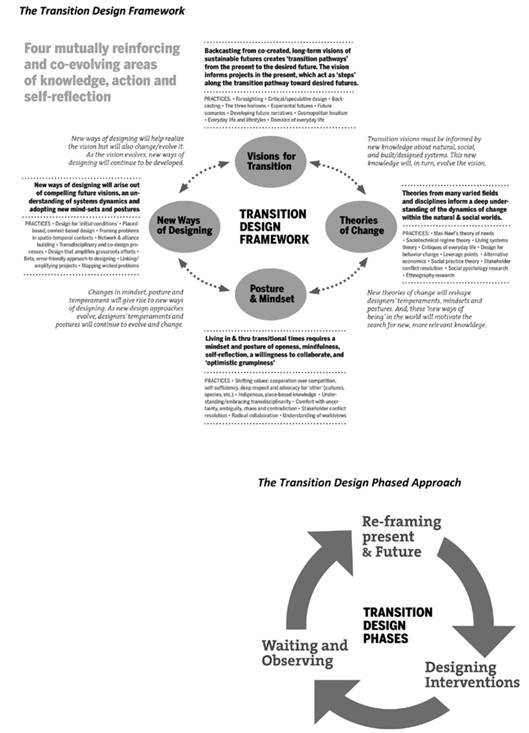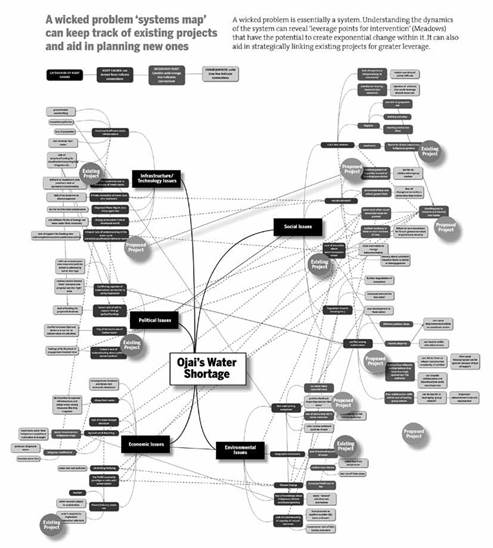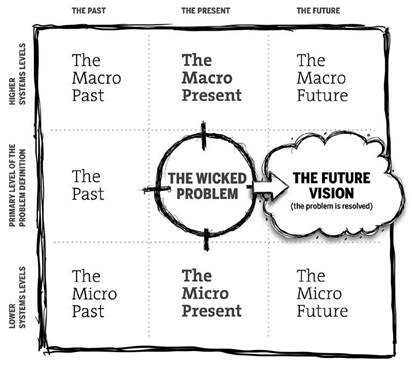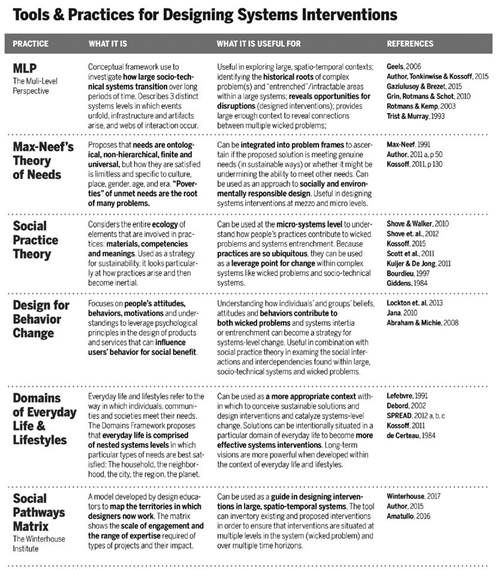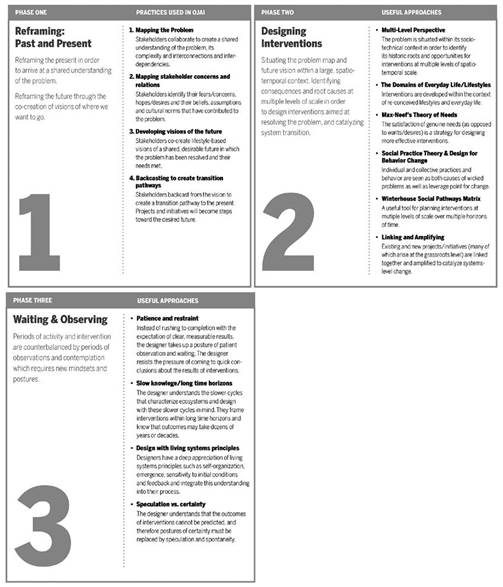The Need for a New Design-Led Approach
A new, design-led approach is needed to address the complex, wicked problems confronting societies in the 21st. century (Hughes & Steffen, 2013; Jensen, 2017) and to seed and catalyse societal transitions toward more sustainable and desirable long-term futures (Porritt, 2013, pp. 274-276). Problems such as climate change, water security, poverty, crime, forced migration, and loss of biodiversity are “systems problems” and challenging for several reasons: 1) they involve multiple stakeholders with conflicting agendas (Dentoni & Bitzer, 2015, p. 68); 2) straddle disciplinary boundaries; 3) are ill defined and stakeholders rarely share an understanding of the problem; 4) the problem is continually changing and evolving; 5) problems exist at multiple levels of scale and are interdependent and interconnected; 6) any intervention (attempted solution) in one part of the system, ramifies elsewhere in unpredictable ways; 7) interventions take a long time to evaluate, and problems, a long time to resolve (Rittel & Webber, 1973, Buchanan, 1995; Coyne 2005; Author, 2011a, 2011b, 2015 ).
Traditional design approaches, characterized by linear processes and de-contextualized problem frames, whose objective is the swift realization of predictable and profitable solutions are inadequate for addressing this class of problem (Author, 2011b, p. 235; Sanders & Stappers, 2008, p. 10; Norman & Stappers, 2016). A more holistic approach is needed to address problems that will take dozens of years or even decades to resolve. A new, design-led approach should:
-- Enable stakeholders to arrive at a shared definition of the problem and an understanding of its complexities and interdependencies
-- Identify stakeholder concerns, relations, expectations and beliefs and factor them into both problem frames and designed interventions in order to leverage collective stake-holder intelligence (Forrester, Swartling & Lonsdale, 2008; GPPAC, 2009, p. 4)
-- Provide a process for stakeholders to transcend their differences in the present by co-creating visions of a shared and desirable long-term future (visioning) -- Frame wicked problems within radically large spatio-temporal contexts
-- Provide stakeholders and interdisciplinary teams with a palette of tools and methodologies useful in resolving wicked problems and seeding/catalysing systems-level change -- Provide a rationale for “intervening” in complex systems and “solutioning” over long periods of time (dozens of years or even decades) vs. creating short-term, one off solutions
The Importance of Stakeholder Involvement in Wicked Problem Resolution and Systems Transitions
Wicked problems and socio-technical systems transitions are challenging because of the high degrees of social complexity which permeate them. Social issues form the roots of many wicked problems, yet often go unseen and unaddressed by traditional problem solving approaches. Identifying these social roots and involving all affected stakehold-ers (Carlsson-Kanyama, Drebord, Moll, & Padovan, 2008; Baur, Elteren, Nierse & Abma, 2010; Simon & Rychard, 2005) is crucial in resolving wicked problems and designing for systems-level change. User-and human-centered design approaches seldom have the objective to identify all affected stakeholder groups and surface their concerns. Rather, these processes identify “key” groups and privilege the concerns of some over others (for example the concerns of the group commissioning a project, perceived target audiences or those of higher socio-economic rank).
Because the distribution of power among stakeholders is almost always unequal (Bauer et. al, 2010, p. 233; Lawhon & Murphy, 2011), if one or two groups are in the position to frame (define) the problem, their needs and concerns will be privileged over those of others. Although traditional design-led approaches consider user preferences and motivations, they seldom examine the individual and collective stakeholder beliefs, assumptions and cultural norms that have contributed to the problem. Social factors such as practices and behaviors are underpinned by beliefs, assumptions (Niedderer, Cain, Lockton, Ludden, Marckrill & Morris, 2014; Ajzen, 1985; 1991) and cultural norms, and must be taken into consideration when framing the problem and designing “systems interventions” (solutions) aimed at its resolution (Incropera, 2016, p. 15).
Transition Design draws on approaches from the social sciences to understand the social roots of wicked problems and places stakeholder concerns and co-design/collaboration at the heart of the problem solving process. We use the term “stakeholder” to refer to any-one who has a stake or interest in a specific issue or is affected by a particular problem. The importance of engaging stakeholders in the problem solving process is well known, particularly in the areas of policy and governance, environmental issues, backcasting and conflict resolution (Grimble & Wellard, p. 173, 1997; Bohling, 2011, p. 4; Quist & Vergragt, 2006, p. 1028; Carlsson-Kanyama, et. al, 2008, pp. 34-35; Global Partnership for the Pre-vention of Armed Conflict, 2015, p. 4), but it has yet to be integrated into most traditional design-led approaches.
An Australian Public Service policy report noted that “a key conclusion of much of the literature about wicked policy problems is that effectively engaging the full range of stake-holders in the search for solutions is crucial” (2007, p. 27). There are many well established methods for engaging stakeholders in relation to complex problem solving, for example: Multi-stakeholder Governance (Helmerich & Malets, 2011), Multi-Stakeholder Processes (MSPs) (Global Partnership for the Prevention of Armed Conflict, 2015) and Stakeholder Analysis (SA)(Grimble & Wellard, 1997).
Participatory Action Research (PAR) (Cornwall & Jewkes 1995; Chatterton, Fuller and Routledge, 2007), focuses upon knowledge for action (p. 1667), and is “aimed at social transformation rather than to use a set of tools aimed at the ‘production of knowledge’ and the ‘solving’ of ‘local’ problems” (Chatterton, Fuller and Routledge, 2007, p. 218). The Global Partnership for the Prevention of Armed Conflict, list the following benefits of multi-stakeholder engagement (MSP) (2015, p. 23):
1.The involvement of more actors provides a broader range of expertise and perspectives. This means problems can be analyzed better, based upon several different viewpoints.
2.Such analyses can lead to a more comprehensive strategy to address complex conflict situations.
3.MSPs provide the opportunity for greater understanding of different stakeholders’ capacities, roles and limitations, thus contributing to better coordination of interventions.
4.MSPs can help organizations pool and share resources, including skills, funding, staff time, and logistical or administrative resources.
5.The involvement of multiple stakeholders can be conducive to public outreach and awareness raising at different levels simultaneously, increasing the reach from grassroots to policy mobilization. In this way, they have potential for multiplier effect when the key messages of the process are communicated to the participants respective constituencies.
6.MPS can contribute to building trust among diverse stakeholders, and enable relation-ships that can outlast the process itself.
7.They can provide a platform for much needed capacity building among practitioners at different levels.
8.Sharing skills and knowledge can enable participants to see problems in a new way, which is also conducive to innovation.
Transition Design argues that stakeholder relations can be seen as the “connective tissue” within a wicked problem, and failure to address these concerns and complex relations, are barriers to problem resolution. Conversely, because stakeholder relations permeate the problem (system), they also have the potential to be leveraged in designing interventions aimed at its resolution (Reed, Graves, Dandy, Stringer, 2009).
The Transition Design Framework and Phased Approach
A Transition Design approach for addressing wicked problems and catalysing systems-level change is emerging. We call it an “approach” rather than a “process” because this work will require a variety of tools and methodologies, used in different ways -no single, prescribed process would be effective in all circumstances. The approach described in this paper emerged out of workshops conducted with the city of Ojai, California to frame their water shortage as a Transition Design problem (Author, 2017) and was informed by coursework in the design program at [Author Institution] and a short courses taught in 2016, 2017 in the UK and Spain. Two key components have emerged: A framework that provides logic for bringing together knowledge and practices outside the design disciplines, and a three-phased approach for applying them to designed interventions. It should be stressed that this approach is still in nascent form and is offered here an invitation to other researchers and practitioners to provide feedback, critique and engagement with the objective of co-constituting a new area of design focus aimed at systems-level change (See Figure 1).
The Transition Design Framework provides a logic for bringing together a variety of practices (knowledge and skillsets outside the design disciplines), situated within four mutual-lyinfluencing, co-evolving areas that are relevant to seeding and catalysing systems-level change: Vision (because we need to have clear visions of what we want to transition to-ward), Theories of Change (because we need a variety of theories and methodologies that explain the dynamics of change within complex systems), Mindset and Posture (because we will need to develop postures of open, that can evolve and change, and which together, form a “palette” from which practitioners and researchers can configure situation-appro-priate designed interventions (See Figure 2).
Figure 1 (top). The Transition Design Framework brings together a body of practices in four key areas useful in designing for systems-level change. (Source: Author) Figure 2 (right). The emerging Transition Design approach suggests three phases comprised of reframing the problem and its context in the present and future, designing interventions, then observing how the system responds. These broad phases accommodate a variety of practices and processes tailored to specific problems and contexts. (Source: Author)
Practices from the framework can be applied within three phases: Re-Framing the Present and Past; Designing Interventions; Waiting and Observing. Rather than a process, these phases suggest the types of action (or inaction) that should be considered when designing for systems-level change.
I. Reframing: The Present and Future
In this phase, stakeholders “reframe” the problem in the present and envision a long-term future in which it has been resolved. Whether it is acknowledged or not each stakeholder affected bya wicked problem has an implicit or explicit vision of the future associated with it (Rawolle, Schultheiss, Strasser, & Kehr 2016, p. 1). Sociologist George Lakoff describes frames as “mental structures that shape the way we see the world” (2004, p. xi-xii). These structures and cognitive models are influenced by metaphors, norms, mass media, politi-cal movements, personal history, etc. and each stakeholder group brings with them, their limited understanding of the problem (problem frame) as well as their fears, expectations and beliefs with them, all of which are influenced by individual and collective “frames”.
Mapping the Problem in the Present
In this step, stakeholder groups collaborate to visually map the wicked problem, identifying as many relationships within it as possible. This process is intended to: 1. Enable stakeholders to achieve a shared definition of the problem; 2. Provide stakeholders with an understanding and appreciation of the complexities of the problem; 3. Develop an appreciation of the limited perspective and knowledge base of each stakeholder group (i.e. no single stakeholder group can solve the problem); 4. Enable stakeholders to adopt collaborative (as opposed to confrontational) postures which aid in transcending differences; 5. Position stakeholder workshop participants as representatives (within their wider community group) of a diversity of stakeholder perspectives; 6. Create a visual ar-tefact (problem map) that can be continually updated and validated through qualitative research and informal feedback, to serve as a rallying point for community education, action and awareness.
The 2007 report by the The Australian Public Service Commission stressed the importance of achieving a shared understanding of the problem among stakeholders:
It can be extremely difficult to make any headway on an acceptable solution to the wicked problem if stakeholders cannot agree on what the problem is. Achieving a shared understanding of the dimensions of the problem and different perspectives among external stakeholders who can contribute to a full understanding and comprehensive response to the issue is crucial (p. 27).
How problems are framed determines how they will be understood and acted upon. Bard-well (1991, pp. 604-605) argues that people solve problems based upon mental models (cognitive maps) assembled over the course of their lives and draw on these subconsciously when encountering new situations. Therefore, people frame new problems in old ways reflecting existing values, assumptions “profoundly impacting upon the quality of solutions.” Because addressing wicked problems will be a new experience for most people, it is imperative that old frames and cognitive models are set aside, in order to reframe the problem using the group intelligence of stakeholders themselves.
An important part of the Ojai problem mapping process involved identifying as many interconnections and lines of relationship as possible between factors/causes. The types of relationships found within a wicked problem such as a water shortage include: inter-dependencies (between the social issue of residents’ lack of awareness/ignorance of the water shortage and the political issue of a lack of support for developing new policies restricting water use), causal relationships (the economic issue of businesses promoting tourism and development is causally related to the environmental issue of the depletion of local water reserves and the environmental issue of the decline of ecosystem health due to the increased demand for water), conflictual relationships (the economic issue of increased tourism is at odds with the social issue of residents facing a water shortage while tourists in the hotels are not compelled to conserve) or affinities (between the political issue of the need to pass new laws limiting water use and alignment with the environ-mental issue of conservationists’ desire to protect the integrity of local water sources) and relationships that feedback on each other (the economic issue of marketing to increase tourism increases the popularity of Ojai as a destination, which results in more people, using more water, which exacerbates the water shortage -a positive feedback loop). These relationships comprise the dynamics within wicked problems often go unaddressed by traditional design approaches (See Figures 3 and 4).
Asking stakeholder groups to map the problem together accomplished several things: 1. Participants discovered facets of the problem they were unaware of, which challenged what they believed to be “true”; 2. The process fostered empathy for the way the water shortage affected other stakeholder groups; 3. Transformed a potentially “confrontational” meeting among opposing stakeholder groups into a co-creation process with elements of discovery and “play”. And, it prepared them for the following step which looks more closely at the relations between groups.
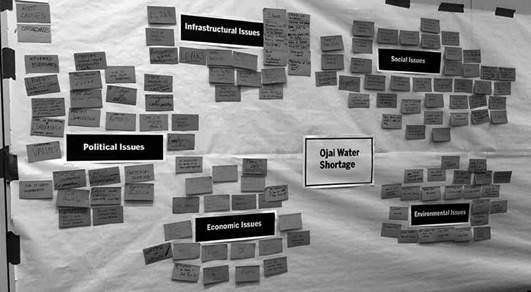
Figure 3 (top). In the Ojai workshops, stakeholder groups mapped contributing factors to the problem in 5 areas: policitcal issues, economic issues, infrastructural issues, social issues and environmental issues. This was accomplished in a ½ day session using post-it notes. A discussion among participants about the interconnections and causal relationships within the problem map informed the creation by workshop facilitators of a higher fidelity map (figure 4). (Source: Author)
Figure 4 (right). Based upon the problem mapping conducted by workshop participants and subsequent discussions, organizers developed this visualization, adding lines of connection and relationship. Green circles demonstrated to the community how new and existing projects and initiatives can act as strategically placed “interventions”aimed at transitioning the system (problem) toward a future of water security. This map is intended as an early “sketch” to guide qualitative stakeholder research aimed at validating or refuting nodes and relationships. In this way the map becomes a visual representation of a community’s collective understanding of the problem of water security. (Source: Author)
Mapping Stakeholder Concerns & Relations
Failure to consider stakeholder concerns, fears, hopes and desires related to the problem can be a barrier to problem resolution. As yet, there is no design-led process aimed at identifying these concerns and integrating them into problem frames and designed interventions. However, in other fields there are many well documented approaches, including Needs-Fears Mapping (Wageningen University, 2017), Conflict Analysis Tools (Mason and Rychard, 2005), and Multi-Stakeholder Processes (Hemmati, 2002), to name a few. These delve more deeply into understanding stakeholder differences, mindsets and relations than traditional design processes (such as actor and stakeholder mapping which often privilege the consultant/expert designer’s or client’s point of view), and offer collaborative processes for resolving conflicts and facilitating more meaningful collaboration and understanding.
What these approaches lack is a design-led component leading to tangible action and material results. For example, designed interactions, communications and artifacts can educate, clarify and facilitate new behaviors and outcomes and permeate socio-technical systems. Transition Design aspires to integrate these stakeholder conflict resolution methods as a strategy for addressing wicked problems.
In the Ojai workshops, stakeholder groups listed both their fears/concerns and hopes/ desires related to the regional water shortage and were asked to identify and label relations among groups. Tape was used to connect points of opposition (red) and points of affinity and alignment (green) (See Figures 5 & 6) to which they added notes explaining the nature of the connection. This informal and rather “boisterous” process interjected an element of discovery, surprise and “play” into what would ordinarily have been a tense and potentially confrontational debate among diverse stakeholder groups about how to solve the problem. The results showed several red lines of stark oppositions (instances in which one stakeholder group’s greatest fear is another’s fondest wish) but these were identified in a spirit of discovery and friendly competition to see how many connections could be identified. Dialog between opposing groups was collegial, even light hearted and stakeholders were surprised at the number of lines of affinity among groups, which became points of positive speculation and discussion.
A final discussion around the large, sprawling map of concerns, fears, hopes and desires focused on how red lines of opposition could be resolved, and lines of affinity leveraged. This shifted the focus from debating differences to conversations about how to resolve them. More research to validate this approach is planned, however early signs show it has the potential to spark dialog among stakeholders with opposing agendas and move them toward collaboration in areas of common interests and objectives. In a final, self-reflective exercise, groups examined the cultural norms, beliefs and assumptions (held by their stakeholder group) that may have contributed to the water shortage. This is challenging work, because few of us are skilled in examining our own worldviews and mind-sets (Lent, 2017; Clarke, 2002; Woodhouse, 1996; Kearney, 1984; Kuhn, 1962) as the roots of a wicked problem. Once stakeholder groups identified their cultural norms, beliefs and assumptions connected to the problem, they were asked: “if by 2050, the problem has been resolved, how would cultural norms, beliefs and assumptions have changed?”
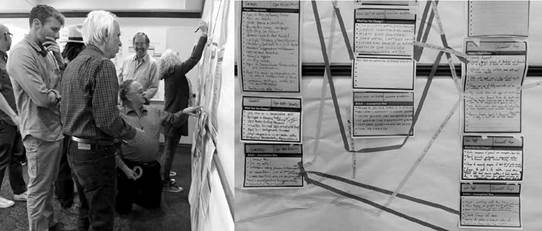
Figure 5 & 6. Stakeholder groups listed their fears/concerns, hopes/desires and the 2017 “believes” about water that might have contributed to the problem (pink and green sheets). Beliefs and assumptions about the problem were listed on the yellow sheets. All of these were hung on the wall and the entire group looked for lines of opposition (red tape) and alignment (green tape) in order to identify conflicts (barriers) as well as alignments that could be leveraged in formulating design interventions. (Source: Author)
At the conclusion of the exercise, each stakeholder group had two sets of contrasting beliefs, assumptions and norms: one set for 2017 (that had contributed to the problem) and a second “future” set from 2050 (that would inform its resolution via the reconception of lifestyles and place-based solutions). As an example, one group articulated their 2017 beliefs as “we believe that water is something to be bought and sold, because there will always be enough of it.” This contrasted with their set of 2050 beliefs: “water is precious and sacred-it is part of ‘the commons’ and everyone has a right to enough. To waste it is seen as a criminal offense.” This exercise, while challenging, marked a distinct change in tone in the workshop. Participants appeared to slow down and became more speculative, even contemplative. Encouraging participants to adopt this new posture (which relates to the Mindset & Posture area of the Transition Design Framework) prepared participants for the following step:
Future Visioning
Transition Design aspires to draw on a range of foresighting techniques that enable stake-holders to co-create compelling visions of long-term, lifestyle-based futures in which the problem has been resolved and many stakeholder fears/concerns addressed and hopes/de-sires fulfilled. These visions help stakeholders transcend present-day differences and they act as both a “magnet” that pulls communities toward co-envisioned, desirable futures, and a compass which guides the design of systems interventions in the present.
The intersection of foresight studies and design has given rise to several new areas of theory, research and practice including Design Fiction (Lindley & Coulton, 2016; Ster-ling, 2005), Speculative/ Critical Design (Dunne & Raby, 2013) and Experiential Futures (Candy & Dunagan, 2017; Candy & Kornet, 2017) that are concerned with envisioning and prototyping both possible and preferable futures. Candy and Dunagan (2017, p. 3) note that “experiential futures [are able to] catalyse high quality engagement, insight, and action to shape change, using whatever means fits the situation” and seek to provide individuals and groups with glimpses of a future that resonates more deeply than other modalities.
New tools and approaches for enabling stakeholders to co-create compelling visions of longterm, desirable futures are needed. Stakeholder groups in the Ojai workshops undertook an exercise called “Snapshots from 2050” to develop lifestyle-based narratives of Ojai in 2050, in which the water shortage had been resolved. Groups were provided with relevant examples of “day in the life” narratives to ensure they remained focused on the holistic process of envisioning/ reconceiving entire lifestyles, vs. the dominant, reductionist approach of envisioning discipline-based solutions. Groups were provided with narrative word/image “templates” and prompted with questions such as: “what would the resolu-tion of the problem make possible for your stakeholder group?”; “what might you be able to do/accomplish that you currently cannot?”; “in what ways would your everyday life (practices, surroundings, profession, home life) look different or be better if the water shortage were resolved?”
Groups used their previously articulated 2050 beliefs, assumptions and cultural norms as the springboard for the futuring exercise. They were asked to consider how their 2050 “worldview” might inform new practices, behaviors and designed interactions, and how artifacts would be part of their narrative. Participants also referenced their earlier lists of fears/concerns and hopes/desires, and speculate about how they would have been resolved or fulfilled in the future, and as a way to develop more concrete examples for the day-in-the-life narratives. In a final group critique, groups reprised the exercise of drawing green lines of affinity and red lines of opposition between the different narratives. The results showed many green lines due to the striking similarities among the visions, and few red lines of opposition. Our hypothesis (which can only be borne out through additional, extensive research with more groups) is that the “space” participants enter into when en-visioning a desired, common future, enables them to transcend opposition and conflict in the present and focus on affinities and similarities in a commonly envisioned, hypothetical future (See Figure 7 and 8).
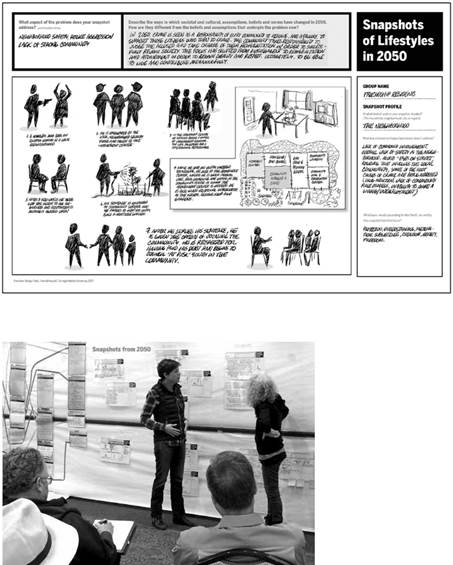
Figure 7 (top). Workshop stakeholder groups were provided with templates and examples of how to develop future, lifestyle- based narratives that incorporate solutions “holistically” in a narrative. This templated provided participants with an example of a future snapshot in which neighborhood crime had been resolved. (Source: author). Figure 8 (left). Each stakeholder group presented their future narrative in a studio-based critique style. (Source: author).
Backcasting
Backcasting (Robinson, 1982) has been successfully used to address long-term, complex societal issues that involve multiple stakeholder groups (Carlesson-Kanyama, et. al., 2008; Quist & Vergragt, 2006). It begins with defining a desirable future then “backcasting” to the present to create a “transition pathway” along which projects, initiatives and programs are positioned as initial “steps” in a longer transition. It differs from forecasting in approach. Forecasting extrapolates current trends (based in dominant paradigms out of which the problem arose) into the future, whereas backcasting attempts to define prefer-able futures, analyze their consequences, and determine the conditions necessary for them to materialize. Robinson (1982) notes
The major distinguishing characteristic of backcasting analysis is a concern, not with what futures are likely to happen, but with how desirable futures can be attained. It is thus normative, involving working backwards from a particular desirable future end-point to the present, in order to determine the physical feasibility of that future and what policy measures would be required to reach that point (p. 337).
Transition Design proposes backcasting as a collaborative activity in which stakeholder groups leverage their visions of desirable futures to inform tangible, consensus-based action in the present.
Due to time limitations, Ojai workshop participants did not delve deeply into this process. Groups were asked to create a transition pathway from the present to their 2050 vision and use post-it notes to speculate on what projects, initiatives, and milestones would be necessary (between the present and 2050) to achieve the vision. This technique draws on the approaches used by Porritt (2013), Carlesson-Kanyama et. al. (1996), and Sharpe (2013) in using backcasting to envision a process of societal transition.
Workshop organizers observed that participants were highly challenged when asked to think in long horizons of time and struggled with the exercise. Further research must be undertaken to evolve the backcasting process for Transition Design, and it is likely that a variety of approaches can be employed and combined in different ways (including the STEEP and Three Horizons tools) (See Figure 9).
Author, Tonkinwise, and Kossoff (2015) have proposed an iterative and cyclical process, shown in figure 10, for backcasting and visioning as the slow process of problem resolution and societal transitions unfold. This process ensures that long-term thinking be-comes common and that future visions do not become “fixed” and static, but rather, are in a continual process of evolution and change, based upon feedback and outputs from present and near-term projects (steps in the transition).
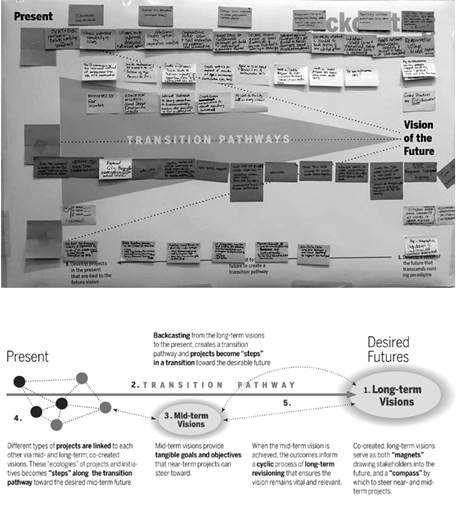
Figure 9 (top). Stakeholder groups mapped a speculative transition pathway from their desired future to the present, with each post-it representing a tangible project/initiative or milestone. Large plotter “canvases” provides participates with a visual structure within which to work. (Source: author). Figure 10 (bottom). Backcasting from a co-created future vision creates a “transition pathway” along which new and existing projects can be connected and situated as “steps” in a long transition toward the desired future. Source: Author, G. Kossoff, C.Tonkinwise.
II. Designing Interventions
Phase 2 situates both the problem map and the future vision within a large, spatio-temporal context (See Figure 11). It also draws on tools and approaches from the Transition De-sign Framework to develop interventions for problem resolution and systems transition. Most design-led approaches situate problems within small, manageable problem frames and contexts in order to arrive at swift, profitable solutions. We argue that wicked problem resolution requires myriad interventions at multiple levels within extremely large spatio-temporal contexts (over long periods of time). Wicked problems exist at multiple levels of scale and always have their roots in the past because it takes years, decades, or even longer for problems to become wicked. It is necessary to look at both higher and lower systems levels to understand the problem’s ramifications and consequences in the present, and look to the past in order to understand the problem’s root causes and evolution.
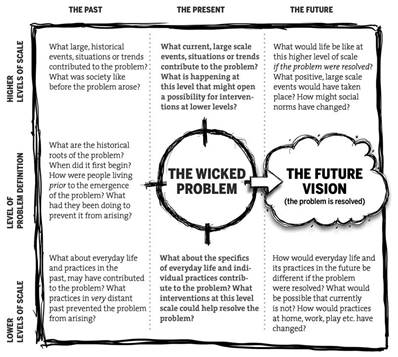
Figure 11 (left). Transition Design draws upon the concept of the Multi-Level Perspective (Geels 2006) to situate both the wicked problem and a future, lifestyle-based vision in a large, spatio-temporal context. This large context is explored in order to identify the most promising points of “intervention” lie within this large context. (Source: author).
Figure 12 (top). Specific questions can be asked at each level in the past, present and future in order to guide research and bring a higher level of fidelity to the future vision. (Source: author)
In essence, phase two of the transition design process involves looking up and down systems levels in space, and backward and forward in time in order to contextualize and address wicked problems -both dimensions play a role in devising interventions (See Figures 11 & 12). Exploring this large context helps us: 1. understand the present-day ramifications and consequences of wicked problems (looking up and down systems levels); 2. Understand how wicked problems evolved and identify their root causes (in the past); 3. Know where to situate interventions aimed at transitioning the system (problem and context) toward the preferred future.
Many of the practices listed in the Transition Design Framework (See Figure 1) will prove useful in the design of systems interventions (both in wicked problem resolution and initiating systems transitions). Due to the limited length of this paper, only six have been listed in Figure 13 on the following page, with an overview of the practice, its relevance to Transition Design and references where more information can be found.
Linking and Amplifying Projects
Many one-off projects and initiatives are often developed to address wicked problems like a water shortage, however Transition Design argues that these are unlikely resolve the problem, or catalyze systems-level change. A new design-led approach must provide a rationale for linking efforts together for greater traction. Linking new and existing projects (from multiple sectors, including service design and social innovation) to each other and long-term visions of co-created, desirable futures is a key Transition Design strategy.
Amplifying projects (Manzini, 2015, pp 123-124; Penin, 2010; Amplifying Creative Com-munities, 2010) refers to the need to look for what is already working at the grassroots level in order to support and “amplify” these efforts. This will call for decidedly different mindsets and postures -that of the non-expert, who approaches a new situation in a pos-ture of empathy and sensitivity to “emergent solutions”. The expert designer mindset that aims to “fix what is wrong” through superior specialist knowledge, whereas the transition designer “looks for what is right” within local, indigenous efforts already underway.
III. Waiting and Observing (Mindset & Posture)
In order to seed and catalyze change in complex systems and resolve wicked problems, multiple interventions, at multiple levels of scale over multiple time horizons will be required. Working with and within large, slow moving systems will involve periods of activity and intervention counter- balanced by intervals of observation and reflection in order to understand how the system has responded to the perturbation. This contrasts with traditional, designled approaches, characterized by fast-paced, linear processes whose objective is clear, predictable, conclusive results (solutions).
Complex systems with large social components (lots of people interacting with each other) display properties of self-organization, including “the spontaneous emergence of new structures and new forms of behavior” (Capra, 1996, p 85). Because these systems are self-organizing, the ways in which they react to perturbations from their environment (designed interventions) are internal and self- determined; i.e. their response cannot be predicted. This is an extremely important principle that, if properly understood, should radically transform traditional design process. The context for these interventions -socio-technical systems and social organizations- will rarely respond to an intervention the way we think it will, and the more complex the system, the more unpredictable its response. This principle of self-organization is why so many meticulously designed solutions fail. Instead of thinking in terms of “designing solutions”, transition designers must think in terms of “solutioning” at multiple levels of scale, over long periods of time. Or, as Wheatley and Kellner- Rogers have said, we must learn to “tinker” things into existence (1996, p. 10). This extremely important part of the Transition Design approach will be highly controversial because it challenges the dominant socio-technical, economic and political paradigms out of which most wicked problems have arisen. These paradigms are based upon a style of thinking that has been widely critiqued and described in turn as “mechanistic”, “reductionist” and “de-contextualized” (Author 2011b, p 254; Capra 1996, 2014; Scott, 1998; Toulmin, 1990; Mumford, 1971; Berman, 1981). Sociologist George Ritzer argues that this style of thinking dominates 21st century society via business models characterized by efficiency, calculability, predictability and control (Ritzer, 2004, pp 12-15). Transition design argues that these same characteristics are found in traditional problem solving process and are -ironically- one of the root causes of wicked problems (Author 2011b, p 235).
Designing for systems-level change will require fundamentally different mindsets and postures (Author 2015, p. 236) and will be slow, patient work with “emergent outcomes.” It will also challenge dominant paradigms that demand fast, concrete, predictable and profitable results. Orr (2002) makes an important distinction between fast and slow knowledge, arguing that
The twentieth century is the age of fast knowledge driven by rapid technological change and the rise of the global economy. This has undermined communities, cultures, and religions that once slowed the rate of change and filtered the appropriate knowledge from the cacophony of new information (p. 36).
The aim of slow knowledge is resilience, harmony and the preservation of patterns that connect (p. 39) and will challenge transition designers to adopt a slower pace and the abil-ity to think in longer horizons of time. Stewart Brand of the Long Now Foundation asks “how do we make long-term thinking automatic and common instead of difficult and rare?” (Brand, 1999, p. 2). Similarly, the “seventh generation” principle from the Great Law of Iroquois Confederacy required its citizens to make crucial decisions with the welfare and preservation of the 7th future generation in mind (Loew, 2014). This type of long-term thinking, along with an understanding of the longer, slower cycles that govern the natural world, must underpin a Transition Design approach.
The Transition Design approach can be compared with Chinese acupuncture. An acupuncturist will closely observe the patient for a period of time in order to understand the imbalances or blocks in the system (body) and then place needles along specific meridians in order to shift energy (this is similar to a practitioner designing systems interventions). After placing the needles, he/she will always wait and observe how the body (system) responds. Sometimes several weeks might go by before another treatment is recommended. The practitioner places needles based upon his/her experience and a “working hypothesis” that a certain response is probable, however a good practitioner will wait to see how a specific individual responds (based upon their own physiology, psychology, lifestyle, etc.) before intervening again. Designing interventions for socio-technical systems will require a similar approach in which periods of action and intervention are punctuated by periods of observation and reflection in order to understand how the system is responding. This process will be at odds with 21st. century expectations for quick, conclusive, profitable and quanti-fiable results. For this reason, the transition designer will also need to develop compelling arguments and narratives about the (long-term) value and benefits of the process itself.
Conclusion
This paper has outlined an emerging, design-led approach for addressing complex, wicked problems and catalyzing societal transitions toward more sustainable futures (See Figure 14). It emphasizes the need to engage all stakeholders affected by the problem in order to create a shared problem definition and understanding of the oppositions and align-ments among them. A framework or “guide” for situating problems within large, spatio-temporal contexts is proposed. This framework can be used to understand root causes and consequences and identify leverage points for interventions aimed at transitioning the system along a transition pathway toward a co-envisioned future.
Transition Design aspires to become a flexible, integrated approach that makes design-led tools and approaches available to transdisciplinary teams working on transition-related projects and initiatives. Still in its nascent phase, it will require researchers and practition-ers from many disciplines and a diversity of cultural perspectives working together to constitute a broadly applicable, transdisciplinary process. This paper is presented as an invitation for critique, speculation and a roadmap for further research.













